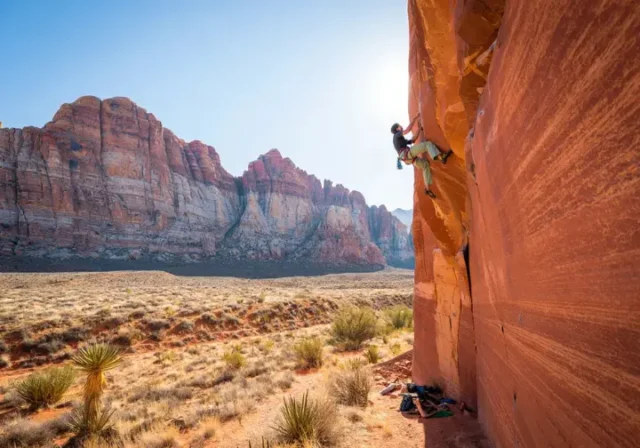In this article
Climbing Red Rock Canyon stands as a premier global rock climbing destination, celebrated for its striking Aztec Sandstone—a unique type of desert rock—and a wealth of diverse climbing opportunities within the Red Rock Canyon National Conservation Area. Planning a trip to this renowned climbing area can seem complex, with permits, seasonal considerations, and varied climbing styles to consider. This guide is your comprehensive solution, offering actionable advice for trad, sport climbing, and bouldering adventures catering to all skill levels. We’ll cover logistics, climbing route selection, essential climbing gear, safety protocols, and responsible climbing practices to help you prepare for an unforgettable experience on these magnificent desert walls of the canyon.
Understanding Red Rock: A Climber’s Paradise
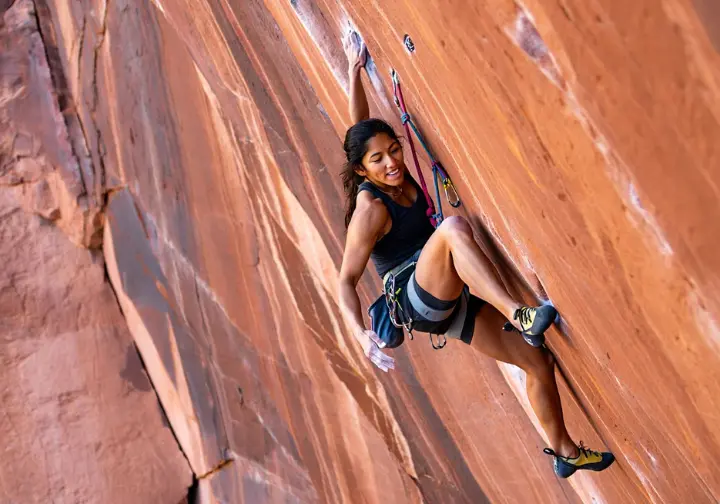
The Red Rock Canyon National Conservation Area offers a unique climbing environment, shaped by its distinct geology and providing a wide array of experiences for rock climbers. Its proximity to Las Vegas, Nevada, makes this part of the desert southwest an accessible yet wild destination for dedicated climbers seeking adventure on world-class sandstone. Understanding its character, especially for Red Rock Canyon rock climbing and the terrain, is the first step to a rewarding Red Rock travel experience in this desert wilderness area.
The Majesty of Aztec Sandstone
The unique characteristics of Aztec Sandstone, its formation through ancient sand dunes, and its varied features like huecos, varnished rock, and cracks, translate to diverse and engaging climbing movements. This sandstone is renowned for excellent friction when dry but becomes incredibly fragile when wet rock conditions prevail. The visual appeal of the rock, with vibrant red, orange, and cream colors of the many-hued rock walls, enhances the aesthetic experience of climbing Red Rock Canyon. The rock texture can range from smooth and featured to sharp and abrasive, influencing climbing technique on the formations and cliffs.
Understanding sandstone’s fragility, especially concerning wet rock conditions, is paramount for every climber. Moisture significantly weakens the dependable rock when saturated, leading to hold breakage and permanent climbing route damage if climbed prematurely after rain. The geological formation of Red Rock includes the Keystone Thrust Fault, a major factor in creating the dramatic cliffs and canyons. For a deeper dive into its properties, consider researching the stunning Aztec Sandstone formations and the importance of understanding wet sandstone climbing; this knowledge is crucial for any trip to the red rocks of nevada. This friable rock demands respect from every environmentally-aware climber.
Diverse Climbing Disciplines Offered
Red Rock Canyon is celebrated for its world-class traditional (trad) climbing opportunities. The climbing area boasts long, adventurous multi-pitch climbs on iconic formations, particularly within Black Velvet Canyon and Pine Creek Canyon, presenting a variety of crack systems and face features that challenge trad climbers. These big adventure climbs are a hallmark of Red Rock. For those interested in the discipline, learning about traditional (trad) climbing opportunities can provide foundational knowledge. Indeed, Red Rock Canyon offers hundreds of established sport and traditional climbs, including many unique crack climbs.
Extensive sport climbing is available, especially in areas like Calico Basin and the Sandstone Quarry. These locations offer a range of grades, from beginner-friendly climbing routes to challenging test pieces, often characterized by bolted face climb on featured sandstone. The bouldering scene is also significant, with Kraft Boulders and Calico Basin serving as primary destinations. Here, climbers find high-quality boulder problems and boulders in various styles, including slab climbing, overhangs, and technical faces, across a wide spectrum of V-grades. A single Red Rock travel trip can often combine these climbing disciplines. For a general overview of climbing at Red Rock, many resources are available. Some climbers even explore aid climbing techniques on the larger walls, a form of technical climbing.
Understanding Red Rock Grades
The primary grading systems used in Red Rock are the Yosemite Decimal System (YDS) for roped climbs (both trad and sport climbing) and the V-Scale (Hueco Scale) for bouldering. YDS uses numbers like 5.9 or 5.12a, while V-Scale uses V0, V5, etc., to denote difficulty for each boulder problem. Red Rock grades, particularly for older traditional climbs and some first ascents, sometimes carry a reputation for being “stout” or “old school.” Climbers new to the climbing area might consider starting a grade or two below their usual limit to acclimatize to the local rock and style of climbing.
Guidebooks (like the Red Book or others) and online resources like Mountain Project are essential for understanding specific route climbs grades and reading climber comments, which offer insights into a climbing route’s true difficulty and character. Consistency can vary between major canyons and even between climbing routes established by different first ascentionists. For official Red Rock Canyon recreation information, including general area details, the Bureau of Land Management (BLM) Red Rock website is invaluable. The reputation of Red Rock grades is something many climbers discuss, similar to other unique desert rock locations.
Essential Trip Planning: Logistics for Climbing Red Rock Canyon
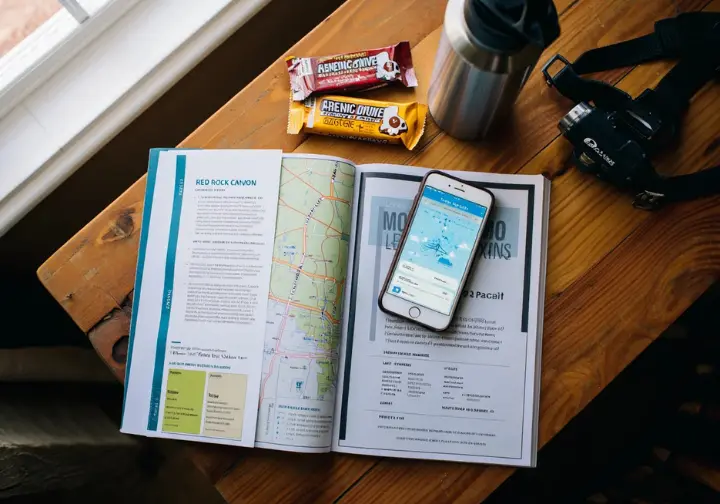
Careful logistical planning is key to a smooth Red Rock Canyon rock climbing trip. This involves understanding the best times to visit, travel arrangements, the critical permit systems, and accommodation choices. Addressing these elements beforehand allows rock climbers to focus on the climbing itself in this part of the desert southwest.
Best Seasons & Weather Wisdom
The optimal climbing seasons, when good climbing conditions are most likely, are generally Fall (October to November) and Spring (March to May), offering pleasant temperatures. The Red Rock climbing season starts in September and continues through May for many. Winter (December to February) can also be good, especially for sunny crags, but may bring cold days and potential snow at higher elevation. Summer (June to September) is extremely hot, often exceeding 100°F (38°C), making midday climbing dangerous; if climbing then, very early starts, shade, and abundant water are vital.
Mojave Desert weather is generally dry but prone to sudden changes, including strong winds and seasonal rain. Always check forecasts before heading out. Shoulder seasons might mean fewer crowds but more unpredictable weather, requiring flexibility. For current conditions and planning your visit to Red Rock, the BLM Red Rock website is a primary resource. Many climbers find these optimal climbing seasons ideal for their trips to Red Rock NCA.
Getting There & Around Red Rock
Red Rock Canyon National Conservation Area lies just west of Las Vegas, Nevada. McCarran International Airport (LAS) is the main airport for visitors flying in. Car rentals from the airport are essential for accessing climbing areas. From the Las Vegas Strip or downtown, follow signs west towards Red Rock Canyon. The 13-Mile Scenic Drive is a one-way paved loop providing access to many main climbing areas within the scenic drive area; its operating hours vary seasonally.
A personal vehicle is necessary for transportation within the park. Parking is available at popular trails and pullouts but can fill quickly, especially on weekends and during peak season. Arriving early is often a good strategy for any Red Rock visitor. For Red Rock Canyon general information including maps and current hours, consult the official BLM site.
Mastering Permits & Access Regulations
The Red Rock Canyon Scenic Drive timed entry system is active for the 13-Mile Scenic Drive, typically from October 1 to May 31, between 8 a.m. and 5 p.m. Reservations are obtained via Recreation.gov for a nominal fee plus the park entrance fee; book well in advance. This is a common aspect of navigating permit systems in popular natural areas. Understanding these rules is key for any Red Rock travel plans.
Late exit permits, also via Recreation.gov, are for climbers on long climbing routes extending beyond Scenic Drive closing hours, allowing exit up to two hours past closure or overnight climb for designated routes in the Red Rock backcountry. Bivy permits are needed for on-route overnight stays on Grade V or very long multi-pitch climbs, applied for through Recreation.gov. Standard park entrance fees apply per vehicle; annual passes like “America the Beautiful” are accepted. The Red Rock Canyon Backcountry Late Exit Pass details are also on Recreation.gov.
Accommodation: Camping & Nearby Options
The official Red Rock Campground, just outside the Scenic Drive, is the primary camping option for climbers. It offers standard, RV, walk-to, and group sites with water and restrooms (no showers). Fees apply, and reservations via Recreation.gov are essential; it’s wise for those booking campsites far in advance. For Red Rock Campground Reservations and official Red Rock campground details, Recreation.gov and the BLM website are your go-to sources. The campground is a popular spot during the Red Rock Rendezvous, a climbing festival.
Given Red Rock‘s proximity to Las Vegas, numerous hotels, motels, and vacation rentals in Summerlin and greater Las Vegas offer alternatives with more amenities, though they involve a daily commute. Dispersed camping on other BLM land outside the Red Rock National Conservation Area is possible but requires adherence to strict regulations and Leave No Trace principles; always check current BLM rules. Some climbers might also look for off-rock activities in Las Vegas.
Navigating the Crags: Key Red Rock Climbing Areas & Routes

Red Rock Canyon boasts a vast expanse of climbable rock, spread across numerous canyons and walls. Each climbing area offers a distinct character, from easily accessible sport climbing crags to remote, committing multi-pitch climbs. Knowing where to go is key to a great adventure for any climber. Red Rock offers a variety of terrain for all.
Calico Basin: Sport & Bouldering Hub
Calico Basin, encompassing the First and Second Pullouts and Kraft Boulders, is a premier climbing area for sport climbing and bouldering. It’s easily accessible outside the main Scenic Drive, though Kraft Boulders (accessible via the Kraft Boulder Trail) has specific parking rules. Its vibrant red and orange sandstone formations are iconic. Calico I and II host a high concentration of sport climbing routes across a wide grade range, mostly single-pitch terrain.
Kraft Boulders is a world-renowned bouldering destination, offering hundreds of boulder problems on high-quality sandstone, from slab climbing to powerful overhangs. Popular classics abound for bouldering enthusiasts. Calico Basin can be very busy, especially on weekends, and parking is often challenging. Respect private property and parking regulations near Kraft Boulders. For an overview of Red Rock climbing areas, Mountain Project is an excellent resource for Nevada find rock information. This area provides excellent mtn/bouldering opportunities.
Black Velvet Canyon: Iconic Trad Adventures
Black Velvet Canyon is home to some of Red Rock‘s longest and most famous multi-pitch traditional climbs, including classics like Epinephrine, Crimson Chrysalis, and Dream of Wild Turkeys. These climbing routes are known for their committing nature and adventurous feel, true big adventure climbs. The climbing here features towering dark varnished rock walls, often involving sustained crack climbing, intricate face sections, and complex route finding, with grades typically moderate to advanced and many climbing routes being Grade III-V. These are some of the great climbs in the Red Rock wilderness.
The approach to Black Velvet Canyon, one of the major canyons, is generally longer and more involved than those in Calico Basin, necessitating early starts for these big ascents. Some bouldering also exists in the lower parts of the canyon, though it’s primarily known for its traditional climbs. Information on Red Rock multi-pitch classics can often be found on sites like SuperTopo. This canyon offers a true wilderness feeling.
Other Notable Canyons & Walls (Pine Creek, Juniper, Oak Creek)
Pine Creek Canyon is another major climbing area for multi-pitch trad climbing, offering climbing routes like Dark Shadows and Frogland in a beautiful setting with varied climbing styles. Juniper Canyon is known for climbing routes on formations such as Cloud Tower and Brownstone Wall, presenting challenging and aesthetic lines for advanced climbers. Oak Creek Canyon is famous for Solar Slab (a very popular moderate multi-pitch climb) and climbing routes on the Eagle Wall, making it accessible for moderate long adventure routes. The Solar Slab is a massive pillar of rock.
Sandstone Quarry and Willow Springs offer a mix of sport climbing and trad climbing, often with shorter approaches and a variety of grades. These areas provide excellent options for days when time is limited or when seeking less commitment than the larger canyon climbs. For those considering guided rock climbing in Red Rock, various mountain guides and services cover these canyons. Exploring these deeper canyons can be a full adventure.
Finding Routes: Guidebooks & Digital Resources
Using up-to-date guidebooks is vital for navigating Red Rock‘s extensive climbing. Jerry Handren’s “Red Rocks: A Climber’s Guide” is widely considered the most comprehensive print Red Rock guide. Other guides by Todd Swain or Jason D. Martin also offer valuable information. It’s wise to combine resources like print guides with digital tools for the best experience when planning your climbing routes.
Mountain Project (mountainproject.com) is an indispensable digital resource for climbing route beta, photos, topos, recent conditions, and climber comments. It perfectly supplements print guidebooks. Digital apps like KAYA or theCrag also offer topos and logging. Guidebooks can be purchased at a local climbing shop like Desert Rock Sports or online. Check Mountain Project for Red Rock bouldering areas or Red Rocks guidebook reviews for community insights.
Gearing Up: Essential Equipment for Red Rock Climbing
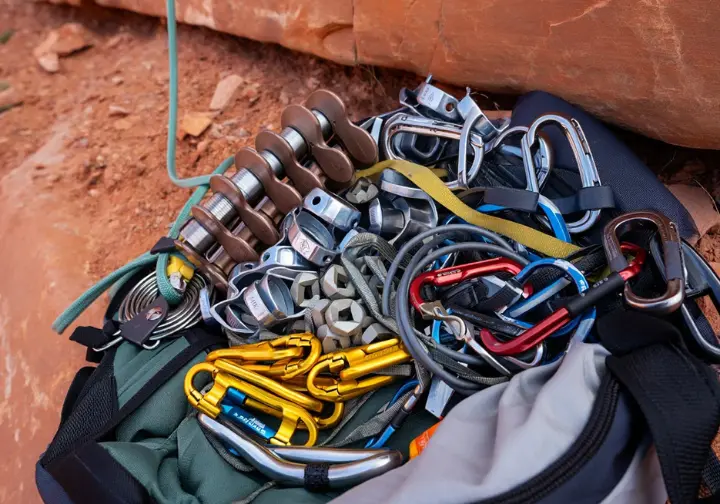
Having the right climbing gear is fundamental for safety and enjoyment in Red Rock. The specific climbing equipment will vary based on your chosen discipline—trad, sport climbing, or bouldering—but some personal climbing equipment items are universally important in this desert environment.
Rope Selection for Red Rock
For rope length, a 60m rope often suffices for many sport climbs and shorter trad routes. However, a 70m rope is highly recommended for greater versatility, especially for longer steep pitches and linking rappels on multi-pitch descents. Understanding rope length considerations is key. Single ropes are common for sport climbing and many trad routes. Double/half or twin ropes can be advantageous for long, wandering trad routes to reduce rope drag and offer rappel redundancy, though they require more complex rope management.
A bi-pattern or bi-color rope is advisable for easily identifying the middle, crucial for rappelling. Rope care in the desert is also important; use a rope bag to protect it from sand and dirt. For discussions on ropes for Red Rocks discussion, online forums can be helpful for climbers.
Building Your Red Rock Trad Rack
A typical standard Red Rock trad rack includes a double set of cams from micro to #3 or #4 (e.g., Black Diamond Camalots or equivalent). Some climbers opt for triples in common sizes for popular climbing routes or longer pitches. A full set of nuts (stoppers) is also essential; varied shapes are useful in sandstone’s irregular cracks. You’ll want plenty of slings—alpine draws or quickdraws with shoulder-length slings are very versatile, typically 10-14 for most climbing routes. This is key climbing gear for adventure-style climbing.
Include a few double-length slings for extending placements or building anchors. Specialized climbing gear like tricams or Big Bros for wider crack climbs can be useful but are less standard for most climbing routes. Prioritize climbing gear that is gentle on the rock. For general Red Rocks climbing gear advice, some dedicated gear sites offer suggestions for rock—for trips.
Sport Climbing & Bouldering Essentials
For sport climbing, you will need quickdraws (typically 12-18, depending on climbing route length), a belay device, and your rope. A sturdy stick clip can be useful, especially on climbing routes with high first bolts, allowing Red Rock lead climbers to clip the first bolt from the ground for added security before starting the climb.
For bouldering, the necessity of multiple crash pads cannot be overstated for safety, given the rocky landings in some Red Rock areas. Consider different types of crash pads (hinge, taco) and a strategy for using them together to cover larger fall zones. Appropriate climbing shoes are vital: softer, sensitive shoes for bouldering and sport climbing, potentially more comfortable, durable climbing shoes for long trad routes. For current Red Rock bouldering information, Mountain Project is a key resource for Red Rock Boulders.
Personal Gear & Desert Must-Haves
Essential climbing specifics include a Helmet (essential for all roped climbing) and recommended for bouldering, a comfortable harness (especially for multi-pitch climbs), appropriate climbing shoes, and a chalk bag with chalk. Desert must-haves include ample water (minimum 3-4 liters per person per day, more in warmer weather on warm rock), sun protection (sunscreen, SPF lip balm, wide-brimmed hat, sunglasses), and a headlamp with fresh batteries—critical for multi-pitch routes and any overnight climb.
For navigation and safety, carry a basic first-aid kit, a map of the climbing area, and potentially a compass or GPS for longer approaches. Always inform someone of your plans. Layered clothing, comfortable approach shoes with good traction for rocky terrain, and a suitable backpack are also important. A Red Rock climbing equipment checklist can be a useful planning tool for your personal climbing equipment.
Safety First: Navigating Hazards & Responsible Climbing in Red Rock
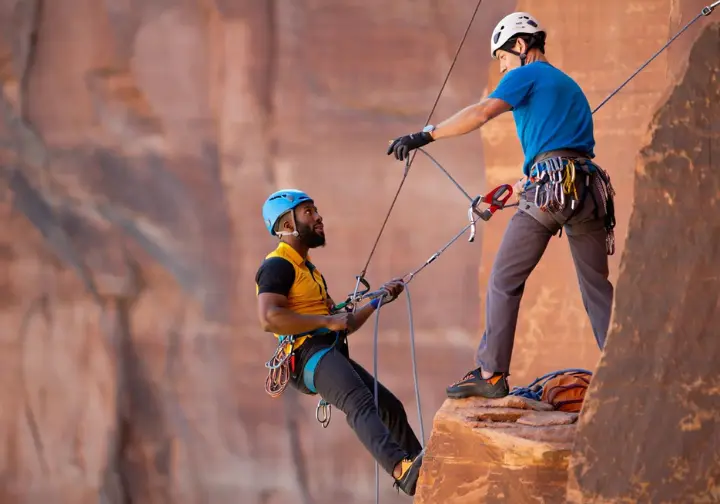
Red Rock‘s beauty comes with inherent risks. Understanding desert-specific hazards, adhering to safety protocols, and practicing responsible climbing are paramount for protecting yourself and this fragile environmentally-aware climber destination. Rock rescue skills can also be beneficial.
The Golden Rule: NEVER Climb on Wet Sandstone
Climbing on wet Aztec sandstone is strictly prohibited and incredibly damaging. The rock loses a significant amount of its strength (up to 75%) when saturated, leading to hold breakage, irreversible climbing route damage, and increased safety risks. This is a critical aspect of avoiding wet rock in desert environments. Wait for dry rock conditions.
Wait a minimum of 24-48 hours after significant rainfall, potentially longer depending on rain intensity, humidity, sun exposure, and rock porosity. Shaded canyons and north-facing walls dry much slower. Assess if rock is dry by looking for uniform light color, feeling for dryness and warmth, and checking for dampness in cracks. If unsure, choose a different activity. This rule is about safety and conservation. For insights into Hinkley Sandstone geology and water, climber forums sometimes have discussions.
Desert Environment Hazards & Mitigation
Heat exhaustion and heatstroke are serious risks, especially in warmer months. Carry and drink ample water, climb during cooler parts of the day, recognize symptoms, and know when to retreat. Be aware of potential encounters with rattlesnakes, scorpions, spiders, and bees; exercise caution when reaching into unseen places. Also, watch out for cacti and other sharp plants along trails.
Desert canyons can be prone to flash floods after rain, even if it’s not raining directly overhead. Check weather forecasts for the broader region and be aware of escape routes. Loose rock is a hazard, especially on less-traveled climbing routes; always wear a helmet. Route finding can be challenging on long multi-pitch routes, requiring careful topo use and good observation. General safe hiking trails Red Rock Canyon advice also applies to approaches and descents for hiking. Adhering to general climbing safety protocols is always important for safe outdoor rock experiences.
Emergency Preparedness & Self-Reliance
Being self-reliant in the Red Rock backcountry is vital. Carry a first-aid kit and know how to use it. Cell service is unreliable or non-existent in many parts of Red Rock; do not depend on your phone. Consider a personal locator beacon (PLB) or satellite messenger for serious situations on remote climbing routes. Always let a responsible person know your climbing plans: location, intended climbing routes, and expected return time. Provide them with emergency contact numbers.
Learning basic self-rescue skills (e.g., escaping the belay, basic hauling/lowering) is valuable for multi-pitch climbers; seek instruction in these techniques from qualified mountain guides or climbing staff. For official park partner information, which often includes contact details, you can check sites like RedRockCanyonLV.org. Developing good rock-craft skills is part of this preparedness.
Leave No Trace: Protecting Red Rock’s Fragile Beauty
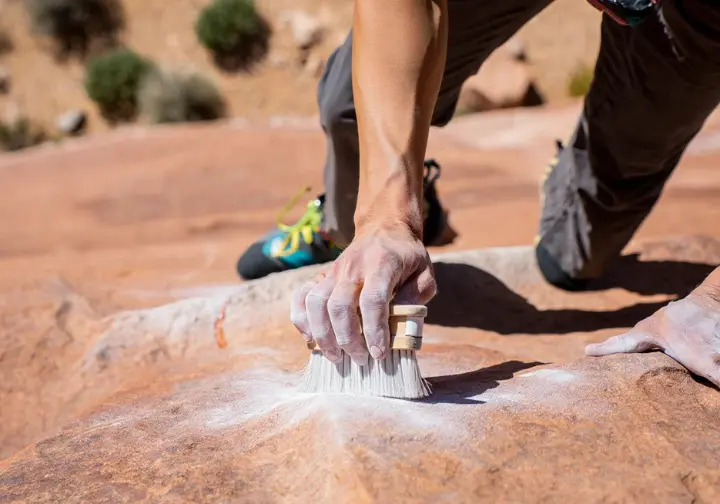
Preserving Red Rock‘s unique desert environment for future generations requires a commitment to Leave No Trace ethics and responsible climbing practices. Every climber plays a part in protecting this special place and its conservation. Red Rock advocates for these principles.
Core Leave No Trace Principles for Climbers
Plan ahead and prepare by knowing regulations and weather. Travel and camp on durable surfaces, staying on established trails and climbing on established climbing routes. Dispose of waste properly: pack out everything, including food scraps, tape, and human waste (use WAG bags where required). Leave what you find; do not disturb natural objects or cultural artifacts. Minimize campfire impacts by using stoves and being aware of fire restrictions.
Respect wildlife by observing from a distance and never feeding animals. Store food securely. Be considerate of other visitors by keeping noise down and sharing routes. These principles are crucial when respecting fragile desert ecosystems. For more on climbing ethics Leave No Trace or general desert climbing ethics, resources from outdoor organizations and park services are helpful. The goal is to keep Red Rock wild.
Specific Sandstone & Bolting Ethics
Reiterating the critical importance of avoiding climbing on wet sandstone is a primary conservation ethic. Minimize chalk application, use chalk colored to match the rock if possible (though less common), and thoroughly brush off tick marks and excessive chalk from holds after climbing. Avoid damaging plants at the base of climbs or on climbing routes. Do not rappel or climber top-roping directly through trees if avoidable.
Most new routing requires approval, and bolting is prohibited in designated Wilderness areas within the Red Rock NCA. Respect local bolting standards and support organizations involved in rebolting and anchor maintenance. For information on local rock climbing ethics and conservation, the Friends of Red Rock Canyon website is a good source. This helps ensure only rock is impacted minimally.
Resources for Success: Guidebooks, Guides, & Local Beta
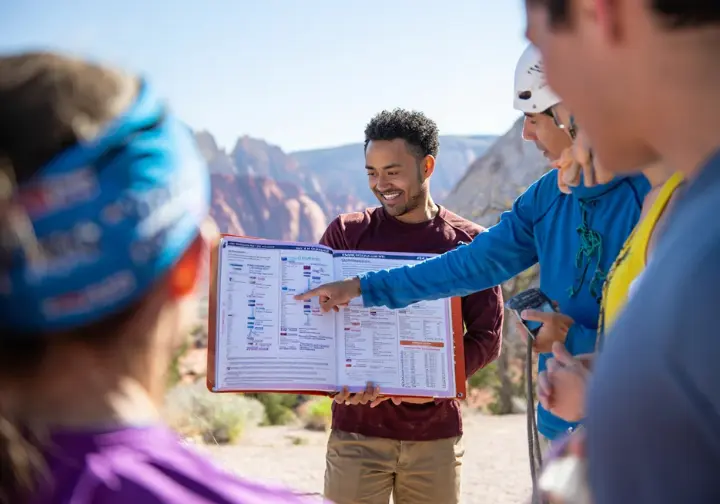
Arming yourself with the right information is key to a successful Red Rock climbing trip. From comprehensive guidebooks to local expert advice from redrockguides or other mountain guides, these resources will help you navigate the canyon with confidence.
Essential Red Rock Guidebooks
Jerry Handren’s “Red Rocks: A Climber’s Guide” is often cited as the definitive resource for its comprehensive coverage, detailed topos, and accuracy, especially for trad routes. Other notable guidebooks include Todd Swain’s “Rock Climbing Red Rocks” or Jason D. Martin’s “Best Climbs Red Rock Canyon” (Falcon Guides), which may offer different selections. Specialized bouldering guides may also exist, though Handren’s guide covers some bouldering. This Red Rock guide is a must-have.
Guidebooks can be purchased at local climbing shops in Las Vegas, such as Desert Rock Sports, which often provide the best selection and can offer advice. Online retailers are another option. An example of Handren’s guide can be found on sites like Amazon: “Red Rock Canyon A Climbing Guide”.
Hiring Climbing Guides & Instruction
Hiring a certified local climbing guide is an excellent option for those new to Red Rock, new to a specific climbing discipline like multi-pitch trad, or wanting to maximize time on classic climbing routes. Benefits include local expertise, climbing route knowledge, safety management, instruction, and often, provision of technical climbing gear. Consider looking into instructional courses if you are looking to build rock-craft skills. Many AAI climbers years of experience can be found with local guides.
Several reputable guide services operate in Red Rock and are permitted by the BLM. Look for American Mountain Guides Association (AMGA) certified guides or accredited services. Services typically include full-day guided climbing, instructional courses, and custom trips. Check directly with guide services for current offerings and costs. For examples of Red Rocks climbing trips or community recommendation for a climbing guide in Red Rock, online searches can provide starting points. This is useful for recreational climbers and even stong climbers looking for specific objectives like the Rainbow Wall or a serious adventure route.
Local Beta: Shops & Online Communities
Local climbing shops in Las Vegas, like Desert Rock Sports, are invaluable resources for the latest conditions, climbing route beta, climbing gear, and local advice. Shop staff are often experienced local climbers. Mountain Project (mountainproject.com) remains the primary online community for Red Rock climbers, useful for checking recent climbing route conditions, access climbs issues, and climber comments.
Other online forums or social media groups dedicated to Las Vegas or Red Rock climbing might share information, but always cross-reference for accuracy. The Las Vegas Climbers Liaison Council (LVCLC) is a local advocacy group involved in access, conservation, and hardware replacement. For the latest alerts and Red Rock Canyon general climbing information, the official BLM page is a key resource. Many Southern Nevada climbers contribute to these communities.
Key Takeaways for Your Red Rock Climbing Adventure
Red Rock Canyon offers a world-class, diverse climbing experience on unique Aztec Sandstone but demands careful planning regarding logistics like timed entry, permits, and seasons, and strict attention to safety, especially concerning wet rock. Thorough preparation, including appropriate climbing gear selection for your chosen discipline—trad, sport climbing, or bouldering—and understanding desert hazards, is crucial for a successful and enjoyable trip for all climbers, from beginner to legendary climbers.
Always prioritize safety and Leave No Trace ethics to protect yourself, fellow climbers, and the fragile desert environment. Consult official sources such as the BLM and Recreation.gov for the most current regulations and conditions. Utilize available resources like comprehensive guidebooks (e.g., Handren’s), online communities (Mountain Project), and local expertise from shops or guides to maximize your Red Rock adventure. This guide provides a solid foundation; now it’s time to plan your ascent and experience the magic of climbing Red Rock Canyon. Remember Red Rock truly is a special place.
Frequently Asked Questions about Climbing Red Rock Canyon
Do I absolutely need a timed entry reservation to climb in Red Rock? >
What’s the single most important piece of gear for Red Rock multi-pitch climbing besides my rack and rope? >
How long do I really have to wait to climb after it rains in Red Rock? >
Is Red Rock Canyon suitable for beginner climbers? >
We are a participant in the Amazon Services LLC Associates Program, an affiliate advertising program designed to provide a means for sites to earn advertising fees by advertising and linking to Amazon.com. As an Amazon Associate I earn from qualifying purchases. We also participate in other affiliate programs. The information provided on this website is provided for entertainment purposes only. We make no representations or warranties of any kind, expressed or implied, about the completeness, accuracy, adequacy, legality, usefulness, reliability, suitability, or availability of the information, or about anything else. Any reliance you place on the information is therefore strictly at your own risk. Additional terms are found in the terms of service.



